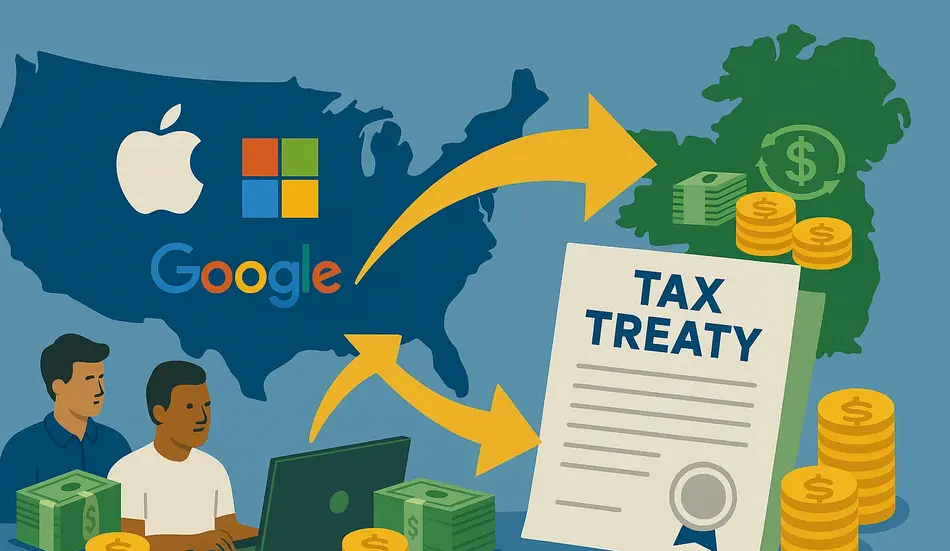Introduction: The US Corporations Ireland Tax Strategies That Changed Everything
The United States is losing billions in tax revenue through sophisticated US corporations Ireland tax strategies that have become the blueprint for multinational tax avoidance. Over the past three decades, American companies have transformed Ireland into a global tax haven, with 25% of US businesses with global operations now having Irish affiliates—up from just 3% in 1996.
This massive shift represents one of the most significant corporate tax avoidance schemes in modern history, with companies like Apple, Microsoft, Pfizer, and Coca-Cola using Ireland’s favorable tax environment to shield their intellectual property and profits from US taxation. The result? American taxpayers are footing the bill while corporations enjoy effective tax rates as low as 1%.
The Rise of Ireland as America’s Tax Haven
How US Corporations Ireland Tax Strategies Evolved
The US corporations Ireland tax strategies didn’t happen overnight. This was a carefully orchestrated plan that began in the 1980s when Ireland was struggling with high unemployment and economic stagnation. The Irish government made a strategic decision to attract US investment through aggressive tax policies.
Key Milestones in the Strategy:
- 1980s: Ireland begins targeting US multinationals with low corporate tax rates
- 1996: Only 3% of US businesses with global operations had Irish affiliates
- 2003: Ireland sets corporate tax rate at 12.5%, one of Europe’s lowest
- 2022: 25% of US businesses with global operations now have Irish affiliates
- Present: Over 950 US firms maintain subsidiaries in Ireland
The Economic Impact on Ireland
The US corporations Ireland tax strategies have transformed Ireland’s economy, but the benefits haven’t been evenly distributed. While the country has seen significant economic growth, much of the wealth generated remains concentrated in corporate coffers rather than reaching Irish citizens.
Ireland’s Economic Transformation:
- Employment: 15% of Ireland’s workforce is employed by US firms
- Investment: Ireland is now the sixth-largest investor in the US
- Growth: Irish economy surpassed US growth by some metrics
- Jobs: Over 150,000 people employed by Irish companies in the US
The Double Irish: The Most Sophisticated Tax Avoidance Scheme
How the Double Irish Strategy Works
The US corporations Ireland tax strategies reached their peak with the “Double Irish” scheme, one of the most sophisticated tax avoidance strategies ever devised. This complex arrangement allowed corporations to make their profits effectively disappear from tax authorities.
The Double Irish Process:
- Two Irish Subsidiaries: Companies create two Irish subsidiaries
- Tax Residency Loophole: One subsidiary is neither a tax resident of Ireland nor considered foreign by the US
- Profit Shifting: Profits are shifted to tax havens like Bermuda or the Cayman Islands
- Tax Evasion: Corporations avoid paying taxes in both the US and Ireland
Real-World Examples of the Strategy
The US corporations Ireland tax strategies have been used by some of America’s biggest companies, with Apple providing one of the most egregious examples. In 2014, Apple’s effective corporate income tax rate in Europe was below 1%, demonstrating the effectiveness of these schemes.
Companies Using Ireland Tax Strategies:
- Apple: Reported effective tax rate below 1% in Europe (2014)
- Microsoft: Continues to report billions in deferred taxes
- Pfizer: Pharmaceutical giant using IP transfer strategies
- Coca-Cola: Leveraging recipe intellectual property transfers
Related Post: Explore Top Jobs on WhatJobs
Looking for opportunities in international business, tax law, or corporate compliance? Visit WhatJobs to explore thousands of verified job postings across all industries. We ensure every listing comes from a legitimate employer—so you can focus on building your career, not dodging scams.
- International Business Positions
- Tax and Accounting Roles
- Legal and Compliance Jobs
- Technology and IT Positions
The Intellectual Property Transfer Game
How Companies Move Their Most Valuable Assets
The US corporations Ireland tax strategies rely heavily on intellectual property transfers, which represent the most valuable assets of modern corporations. By moving patents, trademarks, and proprietary technology to Irish subsidiaries, companies can shift their profit centers overseas.
Intellectual Property Transfer Methods:
- Patent Transfers: Pharmaceutical companies move drug patents to Ireland
- Software Licensing: Tech companies license their software through Irish subsidiaries
- Brand Transfers: Consumer companies transfer brand rights and recipes
- Design Rights: Manufacturing companies move product design rights
The BigComp Example: A Step-by-Step Breakdown
To illustrate how US corporations Ireland tax strategies work, let’s examine a hypothetical tech company called BigComp:
The BigComp Strategy:
- US Parent Company: BigComp Holding Company controls all assets
- Irish Subsidiary: BigComp International based in Ireland
- IP Transfer: Irish subsidiary buys licenses for hardware, software, and design features
- Profit Shifting: Revenue is taxed at Ireland’s lower rate instead of US rate
- Tax Savings: Company pays 12.5% instead of 21% US corporate tax rate
The Economic Consequences for America
Lost Tax Revenue and Its Impact
The US corporations Ireland tax strategies have cost the US Treasury hundreds of billions in lost tax revenue over decades. This represents money that could have been used for infrastructure, education, healthcare, and other essential government services.
Financial Impact on US Taxpayers:
- Lost Revenue: Hundreds of billions in unpaid corporate taxes
- Tax Burden Shift: Individual taxpayers bear more of the tax burden
- Infrastructure Deficit: Reduced funding for public services
- Competitive Disadvantage: Small businesses can’t compete with tax-avoiding giants
The Impact on American Workers and Job Seekers
While US corporations Ireland tax strategies may create some jobs in Ireland, they often come at the expense of American workers and job seekers. The tax savings don’t typically translate into increased domestic investment or higher wages.
Effects on American Employment:
- Job Creation: Some jobs created in Ireland, but often at expense of US jobs
- Wage Suppression: Reduced corporate tax burden doesn’t lead to higher wages
- Investment Patterns: Companies invest in tax optimization rather than domestic expansion
- Small Business Impact: Local businesses can’t compete with tax-avoiding multinationals
Government Response and Policy Changes
The 2017 Tax Cuts and Jobs Act
The US government has attempted to address US corporations Ireland tax strategies through various policy changes, most notably the 2017 Tax Cuts and Jobs Act. However, these efforts have been largely ineffective in closing the loopholes.
Key Provisions of the 2017 Act:
- Corporate Tax Rate Reduction: Lowered from 35% to 21%
- Foreign Income Taxation: Reduced ability to defer US taxes on foreign income
- Minimum Tax Provisions: Attempted to establish minimum tax rates for foreign profits
- Deferred Tax Accumulation: Companies continue to report billions in deferred taxes
International Pressure and OECD Initiatives
The US corporations Ireland tax strategies have attracted international attention, with the Organisation for Economic Co-operation and Development (OECD) leading efforts to address global tax avoidance.
International Response:
- OECD Pressure: International organization targeting profit shifting
- Irish Policy Changes: Ireland phased out Double Irish from 2015-2020
- Global Minimum Tax: International efforts to establish minimum corporate tax rates
- Continued Loopholes: New strategies emerge as old ones are closed
The Future of Corporate Tax Strategies
Emerging Trends and New Loopholes
As governments attempt to close US corporations Ireland tax strategies, companies are developing new methods to avoid taxes. The cat-and-mouse game between corporations and tax authorities continues to evolve.
New Tax Avoidance Trends:
- Digital Services Taxes: Companies adapting to new digital taxation
- Supply Chain Optimization: Restructuring operations to minimize tax exposure
- Alternative Jurisdictions: Exploring new tax-friendly locations
- Legal Innovation: Developing new legal structures for tax optimization
Potential Policy Solutions
Addressing US corporations Ireland tax strategies requires comprehensive policy changes at both the national and international levels.
Proposed Solutions:
- Global Minimum Tax: Establishing minimum corporate tax rates worldwide
- Unitary Taxation: Taxing companies based on global operations
- IP Transfer Restrictions: Limiting intellectual property transfers for tax purposes
- Enhanced Reporting: Requiring detailed disclosure of tax strategies
The Impact on Job Seekers and Career Opportunities
How Tax Strategies Affect Employment Markets
The US corporations Ireland tax strategies have significant implications for job seekers and career development, particularly in technology, pharmaceuticals, and other IP-heavy industries.
Career Implications:
- Job Location: More opportunities in Ireland and other tax-friendly jurisdictions
- Skill Requirements: Increased demand for tax optimization expertise
- Industry Concentration: Certain industries more affected than others
- Salary Impact: Tax savings don’t typically translate to higher wages
Opportunities in Tax and Compliance
The complexity of US corporations Ireland tax strategies has created new career opportunities in tax law, compliance, and international business.
Emerging Career Paths:
- International Tax Law: Specialized legal expertise in cross-border taxation
- Tax Compliance: Ensuring companies meet evolving regulatory requirements
- Transfer Pricing: Managing intercompany transactions and pricing
- Global Business Strategy: Advising on international expansion and tax optimization
Frequently Asked Questions (FAQ)
What are US corporations Ireland tax strategies?
US corporations Ireland tax strategies are sophisticated tax avoidance schemes used by American multinational companies to reduce their tax burden by transferring intellectual property and profits to Irish subsidiaries. These strategies include the Double Irish scheme, IP transfers, and profit shifting to tax havens.
How much tax revenue has the US lost to Ireland tax strategies?
The US corporations Ireland tax strategies have cost the US Treasury hundreds of billions of dollars in lost tax revenue over decades. Companies like Apple have reported effective tax rates as low as 1% in Europe, while the US corporate tax rate is 21%.
What is the Double Irish tax strategy?
The Double Irish is one of the most sophisticated US corporations Ireland tax strategies, involving two Irish subsidiaries where one is neither a tax resident of Ireland nor considered foreign by the US government. This allows profits to be shifted to tax havens like Bermuda or the Cayman Islands.
How do US corporations Ireland tax strategies affect American workers?
US corporations Ireland tax strategies often come at the expense of American workers and job seekers. While some jobs are created in Ireland, the tax savings don’t typically translate into increased domestic investment or higher wages for American workers.
Remember: The US corporations Ireland tax strategies represent one of the most significant corporate tax avoidance schemes in modern history, costing American taxpayers hundreds of billions while creating complex challenges for policymakers, workers, and job seekers alike.




